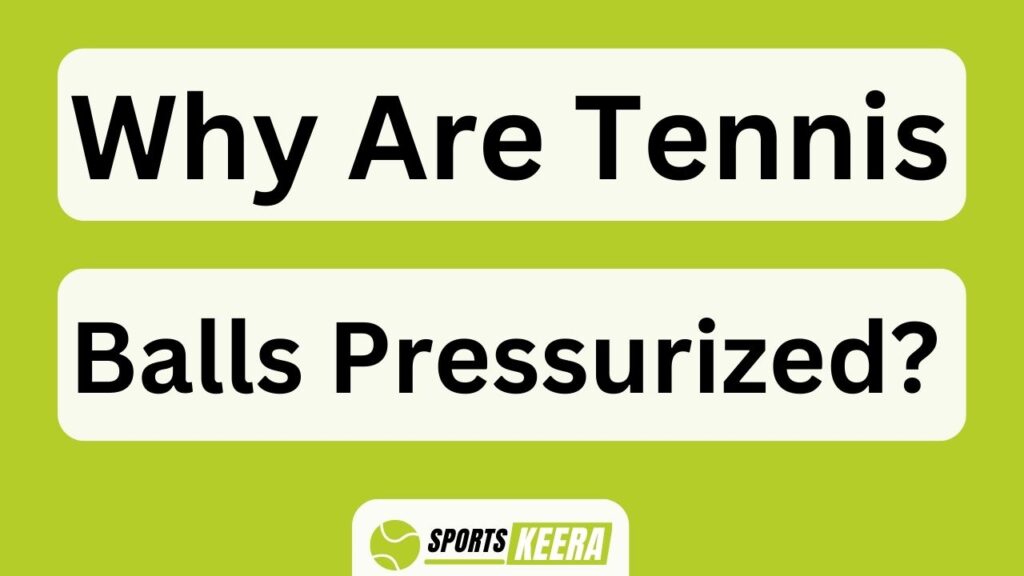Have you ever wondered why tennis balls are pressurized? The answer lies in the quest for consistent bounce and optimal performance on the court. Tennis, a sport that demands precision and skill, requires a ball that can withstand intense impacts and deliver predictable results.
In this article, we will explore the science behind pressurization and its importance in the evolution of tennis balls. Pressurization is a crucial step in manufacturing tennis balls as it affects their elasticity and rebound capabilities. By injecting pressurized gas into the core of each ball, manufacturers create an internal pressure that allows for a consistent bounce throughout a match. This process ensures that players can rely on the ball’s behavior when executing shots, enhancing their playing experience.
Understanding why tennis balls are pressurized not only sheds light on how they have evolved over time but also highlights their impact on professional tennis. Additionally, we will discuss common misconceptions about pressurized tennis balls and provide tips for choosing and caring for them to maintain peak performance.
Get ready to dive into the fascinating world of tennis ball technology!
Key Takeaways Why Are Tennis Balls Pressurized?
- Pressurized tennis balls provide consistent bounce and optimal performance for players.
- Pressurization involves injecting gas into the hollow interior of the ball.
- Factors such as internal pressure, felt covering, and construction influence the performance of pressurized tennis balls.
- Different court surfaces require specific types of pressurized tennis balls for better playability.
The Evolution of Tennis Balls
Did you know that tennis balls have come a long way since their humble beginnings? Over the years, tennis balls have undergone several evolutionary changes that have had both historical significance and an impact on the game itself.
From their initial conception in the 19th century, where they were made of leather filled with hair or wool, to modern-day pressurized rubber balls with a felt covering, tennis balls have transformed into essential equipment for players around the world.
One major evolutionary change in tennis ball design was the introduction of pressurization. Pressurized tennis balls were first introduced in the 1970s and quickly gained popularity due to their ability to provide consistent bounce and improved playability. By filling the core of the ball with gas under pressure, it allowed for a more lively and responsive bounce off the racket strings.
This evolution in tennis ball technology highlights the importance of consistent bounce in the game. With pressurization, players can rely on predictable bounces that enhance their ability to strategize and execute shots effectively.
The subsequent section will delve deeper into why consistent bounce is crucial for players’ performance on the court without sacrificing readability or flow.
The Importance of Consistent Bounce
Ensuring a consistent bounce is vital for players to anticipate and react to the ball’s movement on the court. A tennis ball with an unpredictable bounce would make it difficult for players to accurately judge the trajectory and timing of their shots.
The consistency of the bounce is directly affected by the ball’s performance, which is influenced by factors such as its internal pressure, felt covering, and overall construction. Manufacturers carefully design tennis balls to have a specific level of pressurization that allows for optimal performance and consistent bounces.
The pressurization process involves injecting gas into the hollow interior of the ball, creating a higher internal pressure compared to atmospheric pressure. This controlled level of pressurization ensures that every tennis ball on the court delivers a reliable bounce, allowing players to strategize their moves effectively.
The Pressurization Process
The process of pressurizing tennis balls involves carefully injecting gas into the hollow interior, creating a controlled level of internal pressure that guarantees consistent bounces on the court. Pressurization techniques have evolved over time to enhance ball performance and meet players’ expectations. One common method is known as “nitrogen pressurization,” where nitrogen gas is used due to its non-reactive nature and ability to maintain pressure for longer periods. Another technique is “vacuum sealing,” which removes the air inside the ball completely before resealing it, resulting in a more stable pressure level. The effects of pressurization on ball performance are significant. Higher internal pressure leads to a livelier bounce, allowing players to hit powerful shots with greater speed and accuracy. As we delve further into the topic, it becomes evident that pressurization alone does not determine a tennis ball’s performance; rather, it works alongside other factors such as felt composition and design elements.
The Role of Felt in Tennis Balls
Felt plays a crucial role in determining the performance of pressurized tennis balls. Here are four key aspects to consider regarding the evolution and durability of felt:
1) Material: Traditionally, tennis ball felt was made from woven wool. However, modern tennis balls now use synthetic fibers like nylon or polyester due to their superior durability.
2) Thickness: The thickness of the felt affects how much it compresses upon impact with the racket strings. Thinner felt allows for better control and spin, while thicker felt increases durability but may sacrifice some performance.
3) Density: Felt density impacts both the ball’s bounce and its ability to grip the court surface. Higher density felts provide more consistency in bounce, but may generate less traction on certain courts.
4) Abrasion Resistance: Tennis ball felt must withstand intense friction against hard court surfaces without losing too many fibers. Manufacturers continuously strive to improve the abrasion resistance of felts to extend ball lifespan.
Understanding these factors is essential in comprehending the science behind pressurization, which we will explore next.
The Science Behind Pressurization
To fully understand the impact of pressurization on performance, have you ever wondered how the science behind it influences your game?
Pressurization techniques are not unique to tennis; they are also utilized in various other sports. In soccer, for instance, balls are inflated to a certain pressure to ensure optimal performance and control. In basketball, pressurized balls provide consistent bounce and grip. The same principle applies to tennis balls. When a tennis ball is pressurized, it allows for greater energy transfer upon contact with the racket, resulting in increased speed and power during play.
Additionally, temperature plays a crucial role in maintaining the desired pressure inside tennis balls. As temperatures fluctuate, so does the internal pressure of the ball. This is why professional tournaments store their tennis balls at specific temperatures before matches to maintain consistency. Understanding these scientific factors can greatly enhance one’s understanding of how pressurization affects gameplay.
Transitioning into the subsequent section about ‘the lifespan of pressurized tennis balls,’ it becomes apparent that maintaining proper pressure is essential for optimal performance throughout a match or practice session.
The Lifespan of Pressurized Tennis Balls
As you delve into the discussion of the lifespan of pressurized tennis balls, it becomes evident that understanding their durability is crucial for maximizing your game performance. The lifespan of pressurized tennis balls can vary depending on several factors:
- Frequency of use: Tennis balls tend to lose their pressure and bounce after a certain number of hits, so the more frequently they’re used, the shorter their lifespan.
- Storage conditions: Extreme temperatures and humidity can negatively impact the pressurization of tennis balls, causing them to lose their bounce faster.
- Quality maintenance techniques: Properly storing tennis balls in airtight containers or cans can help retain their pressure for longer periods.
- Type of court surface: Different court surfaces can wear down tennis balls at different rates, affecting their lifespan.
Understanding these lifespan factors and implementing proper maintenance techniques will ensure that you get the most out of your pressurized tennis balls.
Transitioning into the subsequent section about ‘the impact on professional tennis’, it’s clear that maintaining optimal ball performance is essential for competitive play at all levels.
The Impact on Professional Tennis
The impact of ball selection for different surfaces, tournament regulations, and standards in professional tennis cannot be underestimated.
Players must carefully consider the type of ball they use based on the surface they’re playing on. Different balls perform differently on various court types.
Tournament regulations and standards dictate the specifications that balls must meet. This ensures fair play and consistency across matches.
These factors play a crucial role in determining the outcome of professional tennis matches. They also have a significant impact on the overall performance and strategies employed by players.
Ball Selection for Different Surfaces
Choose the right tennis ball for each surface, and you’ll feel like you’re gliding effortlessly across the court as you serve and volley.
When it comes to ball selection, factors such as ball durability and player preference play a crucial role. Different surfaces require different types of balls to ensure optimal performance and minimize wear and tear.
For example, on clay courts, where the surface is softer, players often prefer a heavier ball that bounces higher and slows down on impact. On the other hand, hard courts call for a lighter ball with less felt to enhance speed and agility. Grass courts demand a specific type of ball that has shorter hair on its felt covering to reduce skidding.
These variations in ball design allow players to adapt their game accordingly based on the playing surface’s characteristics. Understanding these nuances is vital for professional tennis players who must adhere to tournament regulations and standards without compromising their gameplay.
Tournament Regulations and Standards
Get ready to dive into the world of tournament regulations and standards, where you’ll discover the dos and don’ts that will keep your tennis game in tip-top shape. When it comes to tournament format, there are various rules and guidelines that ensure fair play and competitiveness. Tournaments can be structured as single-elimination or round-robin, depending on the level of competition.
Player rankings also play a crucial role in determining seedings and match-ups. The higher-ranked players usually receive favorable draw positions, giving them an advantage in their quest for victory.
Now, let’s transition into the subsequent section about ‘the future of tennis ball technology’. As tennis continues to evolve, so does the equipment used in the sport. One area of innovation lies in tennis ball technology.
The Future of Tennis Ball Technology
One exciting development in the future of tennis ball technology is the incorporation of advanced materials, resulting in improved performance and durability. This includes the development of smart tennis balls that can track various aspects of a player’s game, such as speed, spin, and impact force. These smart balls use sensors and wireless technology to provide real-time feedback to players and coaches, allowing for more precise analysis and training.
Another area of focus in tennis ball technology is the creation of eco-friendly alternatives to traditional pressurized balls. These alternative balls are made from sustainable materials and are designed to be biodegradable, reducing environmental impact without compromising performance.
Furthermore, ongoing research aims to enhance the longevity of tennis balls by developing new manufacturing techniques that maintain optimal pressure levels for longer periods. By doing so, players would experience consistent bounce and playability throughout matches or practice sessions.
Advancements in tennis ball technology offer exciting possibilities for both players and sustainability efforts. However, there are common misconceptions about pressurized tennis balls that need clarification.
Common Misconceptions About Pressurized Tennis Balls
The Future of Tennis Ball Technology discussed the advancements in tennis ball design and the potential for new materials to be used. However, it is important to address some common misconceptions about pressurized tennis balls.
Contrary to popular belief, pressurized tennis balls do not have a longer lifespan than non-pressurized ones. In fact, once a can of pressurized tennis balls is opened, they start losing pressure immediately. Additionally, some players mistakenly think that all pressurized tennis balls are the same, when in reality there are different levels of pressure available.
Pressurized tennis balls offer several benefits over their non-pressurized counterparts. They provide better bounce and liveliness on the court, allowing players to generate more power and spin. Furthermore, the pressurization helps maintain consistent performance throughout a match.
Transition: Now that we have debunked these misconceptions about pressurized tennis balls, let’s explore some tips for choosing and caring for your tennis balls to ensure optimal performance on the court.
Tips for Choosing and Caring for Tennis Balls
When it comes to selecting and maintaining your tennis balls, a few simple tips can ensure optimal performance on the court.
When choosing tennis balls, it’s important to consider the type of court surface you’ll be playing on. For hard courts, opt for heavier duty balls that are more durable and have a harder core. For clay or grass courts, choose softer balls with a felt cover that’ll provide better grip and spin.
It’s also crucial to regularly inspect your tennis balls for signs of wear and tear. Replace them when they become too worn out or lose their bounce.
To care for your tennis balls, store them in a cool and dry place to prevent them from losing pressure quickly. Additionally, avoid exposing them to extreme temperatures as this can affect their performance.
By following these tips, you can maximize the lifespan and playability of your tennis balls.
Frequently Asked Questions
How long does the pressurization process take?
The pressurization time for tennis balls varies but typically takes around 2-3 weeks. Pressurization enhances the ball’s bounce and speed by creating a higher internal pressure, resulting in more energy transfer during impact with the racket.
Can the pressurization process be done at home?
Pressurization of tennis balls should not be done at home due to safety concerns. It requires specialized equipment and expertise to ensure proper pressurization. Incorrect pressurization can lead to an imbalance in the ball’s performance and potential injury during play.
Are there any alternative methods for pressurizing tennis balls?
There are no alternative methods for pressurizing tennis balls. Pressurization is necessary to maintain the bounce and performance of the balls during play. The benefits of pressurized tennis balls include improved speed, spin, and control.
Can tennis balls still be used if they lose their pressurization?
Pressurized tennis balls can cause injury due to their increased bounce and speed. When a tennis ball loses its pressurization, its performance is significantly affected, causing it to lose its bounce and become less responsive during gameplay.
Are pressurized tennis balls more expensive than non-pressurized ones?
Pressurized tennis balls are more expensive than non-pressurized ones due to the added manufacturing process required. However, the performance impact of pressurization results in a better bounce and playability on the court.
Conclusion
In conclusion, the pressurization of tennis balls is a vital aspect of the game, ensuring consistent bounce and optimal performance. The pressurization process harmonizes with the felt covering to create a dynamic ball that responds to every swing. The science behind this process is intricate and ever-evolving, driving advancements in professional tennis.
As we look to the future, new technologies will continue to revolutionize tennis ball design, enhancing players’ abilities and taking the game to unprecedented heights.






